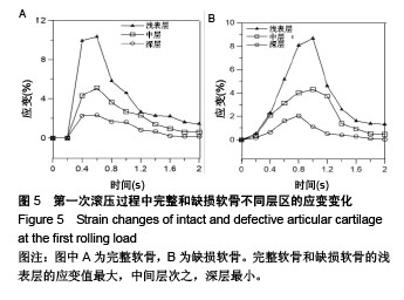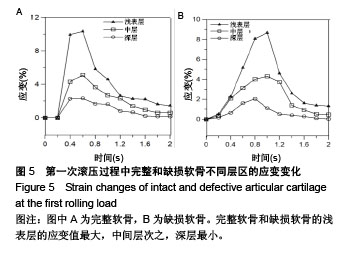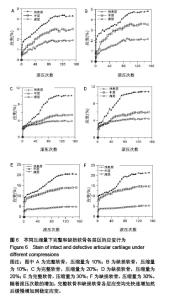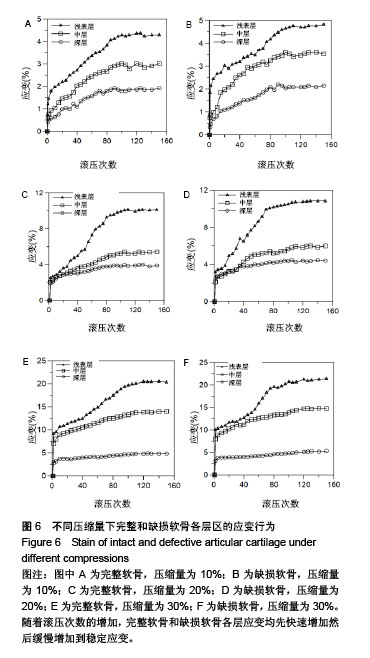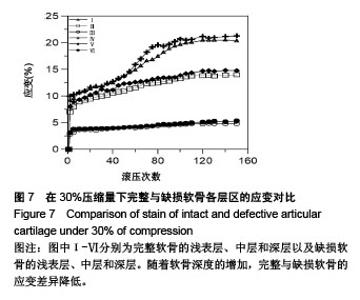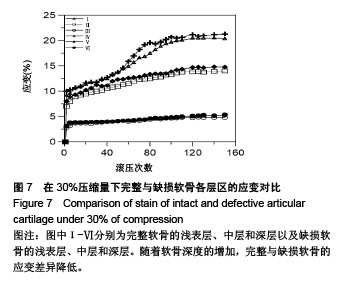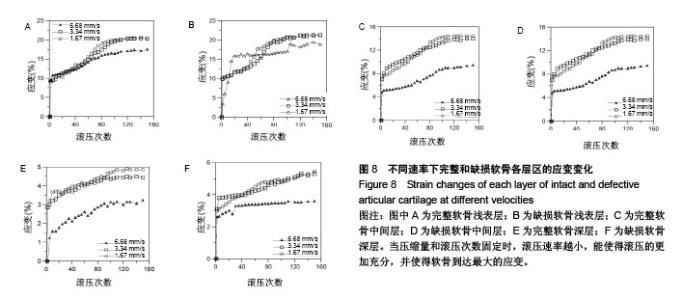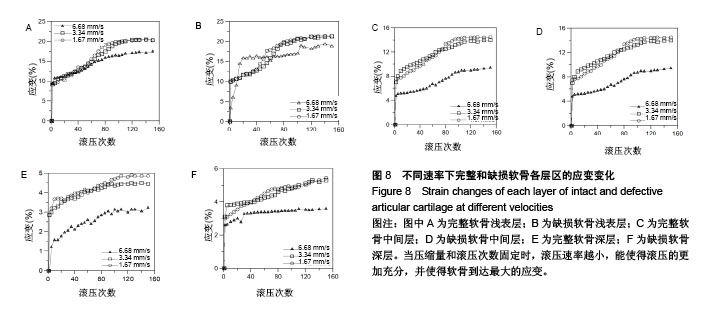| [1] 张光铂,李中实.膝关节功能评定[J].中国康复医学杂志,1991(2):80.[2] Goldring MB, Goldring SR. Osteoarthritis. J Cell Physiol. 2007; 213(3):626-634. [3] Radin EL, Burr DB, Fyhrie D, et al. Characteristics of joint loading as it applies to osteoarthrosis. In: Biomechanics of Diarthrodial Joints. New York: Springer-Verlag, 1990. [4] 尚平,许永涛,廖全明,等.85例半月板损伤与关节软骨损伤相关性研究[J].生物骨科材料与临床研究,2004;1(1):14-15. [5] 陈厚钊,田建强.篮?排?足球运动中发生关节损伤的调查与分析[J].海南大学学报(自然科学版),2008,26(2):192-196.[6] Zurich E. Biomechanical assessment of native and tissue engineered articular cartilage. Nihon Hifuka Gakkai Zasshi. 2006;98(1):26. [7] 晏丹,周广东,曹谊林.关节软骨生化结构及其与力学性能关系研究进展[J].上海交通大学学报(医学版),2009;29(3):341-345. [8] 那键,刘艺,马克勇,等.老年性骨关节炎的分子生物学机制及治疗展望[J].中国老年学杂志,2010,30(20):3035-3037.[9] 陈凯,张德坤,戴祖明,等.牛膝关节软骨的力学承载特性及其有限元仿真分析[J].医用生物力学,2012;27(6):675-680. [10] 李春江,卫小春.力学因素在功能性软骨组织工程学中的作用[J].生物骨科材料与临床研究,2007,4(3):27-30.[11] Guilak F, Butler DL, Goldstein SA, et al. Functional tissue engineering. Springer, 2004:332-400. [12] 戴尅戎.力学生物学在骨与软骨研究中的应用[J].中华骨科杂志, 2006,26(6):429-431.[13] 段航天.压缩载荷作用下关节软骨修复区细胞的力学环境研究[D].天津:天津理工大学,2017.[14] 孟迪.压缩载荷下软骨缺损修复后力学状态的研究[D].天津:天津理工大学,2016.[15] Klein TJ, Chaudhry M, Bae WC, et al. Depth-dependent biomechanical and biochemical properties of fetal, newborn, and tissue-engineered articular cartilage. J Biomech. 2007;40(1):182-190. [16] Wang CC, Guo XE, Sun D, et al. The functional environment of chondrocytes within cartilage subjected to compressive loading: a theoretical and experimental approach. Biorheology. 2002;39(1-2): 11-25. [17] Bian L, Lima EG, Angione SL, et al. Mechanical and biochemical characterization of cartilage explants in serum-free culture. J Biomech. 2008;41(6):1153-1159. [18] Chahine NO, Hung CT, Ateshian GA. In-situ measurements of chondrocyte deformation under transient loading. Eur Cell Mater. 2007;13:100-111; discussion 111. [19] Heuer F, Wolfram U, Schmidt H, et al. A method to obtain surface strains of soft tissues using a laser scanning device. J Biomech. 2008;41(11):2402-2410. [20] 吕雪莹.猪膝关节软骨的动态力学性能测试[D].杭州:浙江大学,2014.[21] 王亚博.骨折技术结合富血小板血浆治疗兔膝关节软骨损伤的生物力学研究[D].石家庄:河北医科大学,2015.[22] 许可,马信龙,张园,等.异常应力条件下关节软骨的变化[J].中国组织工程研究,2010,14(46):8559-8562.[23] 高丽兰,刘志动,张春秋,等.关节软骨不同层区的率相关性能研究[J].医用生物力学,2014,29(2):141-145.[24] Gao LL, Qin XY, Zhang CQ, et al. Ratcheting behavior of articular cartilage under cyclic unconfined compression. Mater Sci Eng C Mater Biol Appl. 2015;57:371-377. [25] 段鑫,陈强,李浪,等.两种软骨缺损模型制备效果比较[J].中国修复重建外科杂志,2016,30(10):1220-1224.[26] Ateshian GA, Wang H. A theoretical solution for the frictionless rolling contact of cylindrical biphasic articular cartilage layers. J Biomech. 1995;28(11):1341-1355. [27] Argatov I, Mishuris G. Elliptical contact of thin biphasic cartilage layers: exact solution for monotonic loading. J Biomech. 2011; 44(4):759-761. [28] 王彦明,余家阔,于长隆,等.关节镜下微骨折术修复膝关节软骨全层缺损的临床疗效观察[J].中国运动医学杂志, 2006,25(6):651-654.[29] Jackson DW, Lalor PA, Aberman HM, et al. Spontaneous repair of full-thickness defects of articular cartilage in a goat model. A preliminary study. J Bone Joint Surg Am. 2001;83-A(1):53-64. [30] 顾延,戴克戎.应力降低导致关节软骨退变机理的形态学研究[J].中华骨科杂志,1995,15(9):631-633.[31] Gratz KR, Wong BL, Bae WC, et al. The effects of focal articular defects on cartilage contact mechanics. J Orthop Res. 2009; 27(5):584-592. [32] Patel VV, Hall K, Ries M, et al. A three-dimensional MRI analysis of knee kinematics. J Orthop Res. 2004;22(2):283-292. [33] Doherty M. Osteoarthritis: diagnosis and medical/surgical management annals of the rheumatic diseases 1992;51:1028. [34] Bachrach NM, Mow VC, Guilak F. Incompressibility of the solid matrix of articular cartilage under high hydrostatic pressures. J Biomech. 1998;31(5):445-451. [35] 邵越峰,卫小春.不同力学刺激对软骨基质代谢的影响[J].中国骨与关节损伤杂志,2008,23(11):965-968.[36] Ateshian GA, Warden WH, Kim JJ, et al. Finite deformation biphasic material properties of bovine articular cartilage from confined compression experiments. J Biomech. 1997;30(11-12): 1157-1164. [37] 翁习生,仉建国,张嘉.髌骨软骨粘弹特性的实验研究[J].中国医学科学院学报,1999,21(1):53-54.[38] 孟广伟,程杰平,马洪顺.髌骨软骨拉伸应力松弛蠕变实验研究[J].医用生物力学,2003,18(4):239-243,255.[39] 程潭,张柳,张英泽,等.大鼠膝关节不稳定骨性关节炎软骨与软骨下骨组织微观结构的变化[J].中国矫形外科杂志, 2012,20(3):267-270.[40] 陆宁,卢世璧,王继芳,等.采用自体成熟关节软骨细胞的软骨组织工程修复[J].中华实验外科杂志,2005,22(3):293-296. |
